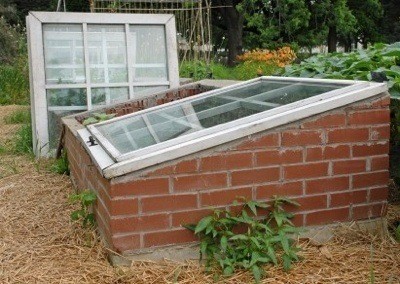
Using a cold frame is a great way to protect your plants from cold damage during the transition months on either side of the growing season. A homemade cold frame can work just as effectively as a commercial model, and you can build one yourself for a lot less money. Although building your own means you can make it as fancy as you wish, all you really need is a bottomless box, a transparent cover, and a location that captures as much of the sun as possible.
The mechanics of how a cold frames works are simple. During the day the sun heats the air and soil inside of the frame, creating a favorable growing environment for your plants. At night, heat stored in the soil keeps the temperature inside the cold frame warmer than the outside temperature, and helps protect the plants from cold damage.
To let in the sun's rays, the cover of your cold frame needs to be transparent. It can be secured to the box with hinges or simply laid across the top and weighted down with rocks. Here are some examples of good cover materials:
Determining size: The size of the cover and framing materials you choose may ultimately predetermine the size of your cold frame - for example, if you're reusing an old window sash or you plan to use straw bales to construct the box. In general, try to keep the size of your cold frame to no more than 2 to 3 feet wide and 4 feet long. This will allow you to house a variety of plants, while still keeping them within easy reach.
The box of your cold frame should slope toward the front (e.g. 18 inches in back, 12 inches in front). This will help trap sunlight, create headroom for taller plants, and direct rainwater off of the frame. The box of the cold frame can be constructed from a variety of materials:
For strength, reinforce the corners of the box with vertical one-by-two inch posts, making sure the posts are flush with the top of the box. For added insulation you can line the frame with plastic, and seal the edges with weather-stripping. Wood frames should be constructed using galvanized nails. Use screws or hinges if you plan to disassemble the frame for seasonal storage. As a final step, place a thermometer inside the box where it will remain easily visible so you can monitor the interior air temperature.
Place your cold frame over a garden bed in a location that is protected from harsh winds. Ideally, the site you choose will be close to your house. This will make it easier for you to monitor the plants and give you convenient access to water. For maximum sun, place it against a south-facing wall of your house, and orient it so the frame tilts to the south. If a southern exposure isn't possible, an east-or-west facing location is the next best choice.
Ventilation: Your cold frame needs to be properly ventilated to prevent the air inside from overheating and killing your plants. As a general guideline, if a sunny day is in the forecast, prop the cover open a few inches in the mid-morning (or when the interior temperature reaches 70-75 degrees F), and close it again before sunset. If the forecast calls for an unusually cold night, insulate the frame by throwing a blanket over the top to help trap daytime heat inside.
If you can't be around to monitor the temperature of your cold frame during the day, consider investing in a solar activated venting arm that automatically opens and closes the cover at a preset temperature. These devices are non-motorized and are available through greenhouse supply companies (and online) for as little at $40.
Moisture levels: The plants in your cold frame should be kept moist, but not soggy. Depending on the weather, daily watering may be necessary, especially for seedlings or plants growing in small pots. Watering should be done in the morning so the moisture has a chance to evaporate before the cover is closed overnight.
Spring: Use it to speed up germination and get an early start on cool season vegetables, or to harden off seedlings that were started indoors.
Summer: Replace the cover with a shade cloth and use it as a nursery for rooting and propagating young plants.
Fall & winter: Extend the harvest season by planting greens or herbs in your cold frame in late summer, or use it to over-winter bulbs intended for early-spring forcing.

About The Author: Ellen Brown is an environmental writer and photographer and the owner of Sustainable Media, an environmental media company that specializes in helping businesses and organizations promote eco-friendly products and services.
Add your voice! Click below to comment. ThriftyFun is powered by your wisdom!